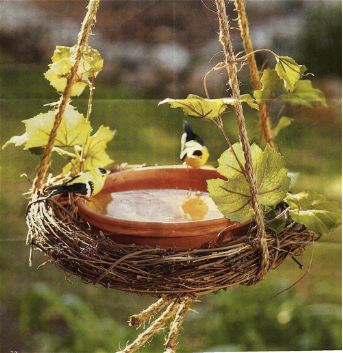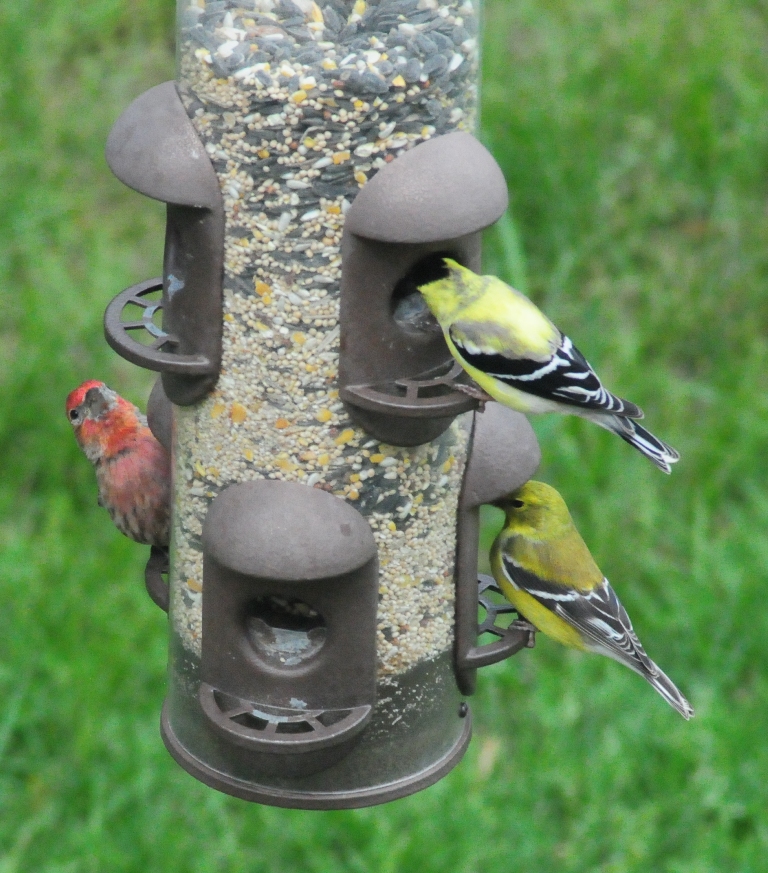-
Make a Hanging Bird Bath
 Fresh water is hands-down the best way to entice wild birds to your yard. Birdbaths really do attract feathered friends and keep them coming back… even more so than houses or feeders! Baths can range from pedestal styles to ground or deck mounted models, and of course hanging bird baths. Found in materials like ceramics, stoneware, copper and glass, birdbaths range from simple to elaborate works of art for ultimate garden decor.
Fresh water is hands-down the best way to entice wild birds to your yard. Birdbaths really do attract feathered friends and keep them coming back… even more so than houses or feeders! Baths can range from pedestal styles to ground or deck mounted models, and of course hanging bird baths. Found in materials like ceramics, stoneware, copper and glass, birdbaths range from simple to elaborate works of art for ultimate garden decor.You needn’t spend a small fortune to have a bird bath though, any shallow container that holds water works just fine for birds. A pretty plant saucer will make a great bathing spot. If ground predators lurk in the area, it’s best to raise the bath off the ground. The most important thing is the water be fresh. What’s the best kind of birdbath? The one you are willing to maintain.
This clever hanging bird bath can be made very quickly and inexpensively. Necessary materials are rope, a plastic plant saucer and a grapevine wreath, the decorative leaves are strictly optional.
First cut three pieces of rope- 5 feet in leng
 th. Knot them together at both ends, and place the grapevine wreath inside the ropes as shown here. Next place the saucer inside the wreath. If you opt for the decorative leaves, simply tuck them into the wreath and wind them around the ropes. Use more rope for hanging if necessary.
th. Knot them together at both ends, and place the grapevine wreath inside the ropes as shown here. Next place the saucer inside the wreath. If you opt for the decorative leaves, simply tuck them into the wreath and wind them around the ropes. Use more rope for hanging if necessary.Fill with water and enjoy birds at their new refreshing oasis!
-
Colors Are Changing at the Finch Bird Feeder
 When one thinks of finches, it’s thistle or nyjer seed that usually comes to mind. This is a staple for finches, especially American Goldfinches. Here at this tube feeder, it seems goldfinches and a purple finch are chowing down on a standard seed mix. Both will feed on sunflower seed, and possibly some other goodies in the mix.
When one thinks of finches, it’s thistle or nyjer seed that usually comes to mind. This is a staple for finches, especially American Goldfinches. Here at this tube feeder, it seems goldfinches and a purple finch are chowing down on a standard seed mix. Both will feed on sunflower seed, and possibly some other goodies in the mix.No matter what type of seed your finch bird feeder may be offering, you can count on the fact that mother nature takes her course regardless. Very soon, the vibrant yellow feathers we’ve seen all summer on sweet goldfinches will give way to a more olive-drab color. It’s the second molt of the season for goldfinches, when nature sheds the old tattered feathers and outfits birds with a new set to help brave the winter.
Cardinals are also going through the molting process now, and may appear a little scrawny or sickly-looking. Know that they’re healthy and just preparing to suit up in their vibrant red plumage.
The molting process of fall also signals the migration of many songbirds. Vireos, Warblers and more are on their way to southern wintering grounds. These birds need fuel and refreshments along the way in order to stay fat for the long journey. Placing suet out now is a great way to help migratory birds, with a high fat and protein snack that packs in the calories. Fresh water also helps migratory songbirds on their journey. A birdbath may serve as an oasis to some of these weary travelers. Keep an eye out for visitors to your yard…you never know who may stop by!
-
Crowded Thistle Feeders?
 With tons of Goldfinches out and about now, thistle feeders are likely to be a very busy spot in your yard. Because Goldfinches are one of the latest breeding/nesting birds, many juveniles are now crowding thistle feeders and learning to eat on their own. One of the favorite songbirds who will winter-over if thistle (or nyjer) is offered on a consistent basis, Goldfinches will grace your garden all year. A heated birdbath is also another major attraction for these sweet birds to stick around.
With tons of Goldfinches out and about now, thistle feeders are likely to be a very busy spot in your yard. Because Goldfinches are one of the latest breeding/nesting birds, many juveniles are now crowding thistle feeders and learning to eat on their own. One of the favorite songbirds who will winter-over if thistle (or nyjer) is offered on a consistent basis, Goldfinches will grace your garden all year. A heated birdbath is also another major attraction for these sweet birds to stick around.With one of their two upcoming seasonal molts, vibrant yellow plumage will soon give way to a more olive-drab one. But as spring once again approaches, the electric yellow feathers will be seen through late summer and early fall.
The use of Thistle Socks or Thistle bags will help to alleviate crowds at your regular thistle feeders, and ensure that all babies get to eat. Fairly inexpensive and available from small to large, these mesh stockings provide an “all-over” eating area for finches and other birds who prefer thistle seed.

Cardinals are also molting right now, and although they might look a bit sickly…rest assured it’s just the process of shedding old worn feathers for vibrant new ones.
